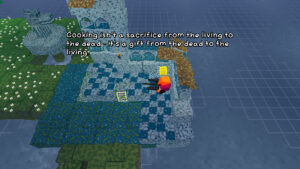Stephen’s Sausage Roll: Facing the End
 So, it turns out that the backstory of Stephen’s Sausage Roll totally goes there, but not quite in the way I had expected. The feel is less squick than melancholy. Sadness at the passing of a civilization, at the loss not just of its physical forms, its buildings reduced to ruins and its people grotesquely dehumanized, but of its past, as all the knowledge that the people sought to preserve all their lives vanishes with no one to remember it. Like Link on Koholint, it’s questionable whether anything that happens on the island is anything more than a dream — a lingering dream of the doomed and dead, that confuses and combines the old celebratory feasts with the funeral rites that dominated their final days. Preparing the dead meat for its final rest.
So, it turns out that the backstory of Stephen’s Sausage Roll totally goes there, but not quite in the way I had expected. The feel is less squick than melancholy. Sadness at the passing of a civilization, at the loss not just of its physical forms, its buildings reduced to ruins and its people grotesquely dehumanized, but of its past, as all the knowledge that the people sought to preserve all their lives vanishes with no one to remember it. Like Link on Koholint, it’s questionable whether anything that happens on the island is anything more than a dream — a lingering dream of the doomed and dead, that confuses and combines the old celebratory feasts with the funeral rites that dominated their final days. Preparing the dead meat for its final rest.
This concern with legacy even informs the final few puzzles. The final chapter is largely concerned with puzzles that have mobile components other than sausages, and one of the things you notice as you go along is that they’re only mobile in puzzle mode. Once you’ve solved the puzzle, they’re frozen in their final positions. Some places take advantage of this to control exploration: solving a puzzle might require pushing some blocks to form a bridge to the grill, and once you’re outside the puzzle and the rest of the world comes back, you use the same bridge to advance to the next puzzle. But this isn’t something you really have to think about until the last few puzzles, where you can easily cook all the sausages and still leave things arranged wrong, blocking off further progress. It isn’t enough to deal with the remnants of the past. You now have to think about the future as well. This is the game’s last big twist.
The climactic puzzle makes it almost inevitable that you’ll mess this up at first. I honestly thought it was just a victory lap, a puzzle in name only that just gives you a whole bunch of sausages in an open space with nothing preventing you from cooking them, as a reward for getting through everything else. I should have known SSR would never do anything that friendly. It is, instead, a puzzle that’s all about setting things up so you can climb a spire after the puzzle is closed. The sausages are basically irrelevant. The game had the power to make difficult non-sausage-based puzzles all along and is only now pointing this out.
And after you’ve done that, then comes the real victory lap: the grills throughout the world light up outside of puzzle mode. Finally, you can cook the remaining overworld sausages! I observed before that you always have the ability to walk all the way back to the beginning of the game, if you’re so inclined, and now the game motivates you to do so. To revisit in reverse all the places where you spent so much time. The people of the island strove to preserve their memories and memorials, and now you have memories of your own associated with the island. So of course you share their fate in the end. In another game, this would come off as cheap irony, but here, it’s really the only possible way to cap off the game’s themes.
 Comments(2)
Comments(2)
Is it overreading it if I think that the knowledge that the learned people were trying to preserve is the knowledge of how to solve the puzzles? So that you’re paying respect to them not only by grilling and eating them, but by recapitulating their knowledge?
One thing about the last puzzle is, not only does it switch to a non-sausage-based puzzle, it is (I think) the only puzzle with gratuitous repetition. There are puzzles where you have to do the same thing to two different sausages because one was an obstacle or prop for the other, and then they switch places, but the puzzle requires both sausages to work. This would effectively be the same puzzle with three objects to stack instead of eight. The repetitive stacking of things that are much larger than you gives it a ritualistic, monumental quality, after what has been a monumental achievement. The last puzzle doesn’t have to be difficult to do justice to the game, but it does have to be big.
(I also think that the impact would’ve been greater without the previous puzzle that required you to set up the overworld properly. In that one putting the pieces in the right place isn’t that difficult, but it’s fiddly, because you can’t see where they’re going to wind up when you’re in the level.)
To some extent, the repetition is part of the puzzle. My own first attempts at building the tower were improvisational and chaotic, and beyond a certain point didn’t work any more. It took me a while to find a technique for raising blocks that could be iterated indefinitely.